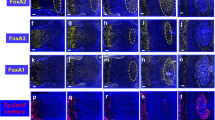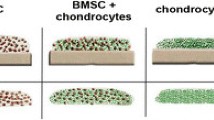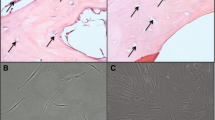Abstract
Purpose
The aim of this study was to investigate the proliferation and differentiation behaviour of a defined cell population gained from the human growth plate, namely, chondro-progenitorcells (CPCs), in the initial inflammatory phase of growth plate injury response in vitro.
Methods
Growth plate cells were sorted via FACS and differentiated along adipogenic and osteogenic lineage to confirm their progenitor features. To mimic the inflammatory phase of injury response at the growth plate they were treated with IL-1β and exposed to cyclic mechanical loading. A BrdU assay was used to investigate CPC proliferation. CPC differentiation behaviour was analysed by RT-PCR.
Results
CPCs (CD45-, CD34-, CD73+, CD90+, and CD105+) showed a successful differentiation along adipogenic and osteogenic lineage. Under conditions simulating the inflammatory phase of injury response at the growth plate in vitro CPCs differentiated towards hypertrophy while chondrogenesis and ossification were inhibited. Proliferation was not significantly altered.
Conclusion
This study showed that CPCs can be isolated from the human growth plate and expanded in vitro. In the first phase of injury response at the growth plate these cells differentiate towards hypertrophy. As longitudinal growth is obtained by chondrocyte proliferation and volume increase during hypertrophy this maturation might be the first step towards post-traumatic growth disorders such as unwanted premature ossification of the growth plate.




Similar content being viewed by others
References
Olsen BR, Reginato AM, Wang W (2000) Bone development. Annu Rev Cell Dev Biol 16:191–220
Wattenbarger JM, Gruber HE, Phieffer LS (2002) Physeal fractures, part I: histologic features of bone, cartilage, and bar formation in a small animal model. J Pediatr Orthop 22(6):703–709
Shapiro F (1987) Epiphyseal disorders. N Engl J Med 317(27):1702–1710
Chung R, Foster BK, Xian CJ (2011) Injury responses and repair mechanisms of the injured growth plate. Front Biosci (Schol Ed) 3:117–125
Zhou FH, Foster BK, Sander G, Xian CJ (2004) Expression of proinflammatory cytokines and growth factors at the injured growth plate cartilage in young rats. Bone 35(6):1307–1315
Chung R, Cool JC, Scherer MA, Foster BK, Xian CJ (2006) Roles of neutrophil-mediated inflammatory response in the bony repair of injured growth plate cartilage in young rats. J Leukoc Biol 80(6):1272–1280
Ueki M, Tanaka N, Tanimoto K, Nishio C, Honda K, Lin YY et al (2008) The effect of mechanical loading on the metabolism of growth plate chondrocytes. Ann Biomed Eng 36(5):793–800
Winter DA (1983) Biomechanical motor patterns in normal walking. J Mot Behav 15(4):302–330
Kolf CM, Cho E, Tuan RS (2007) Mesenchymal stromal cells. Biology of adult mesenchymal stem cells: regulation of niche, self-renewal and differentiation. Arthritis Res Ther 9(1):204
Ballock RT, O'Keefe RJ (2003) The biology of the growth plate. J Bone Joint Surg Am 85(4):715–726
MacRae VE, Farquharson C, Ahmed SF (2006) The pathophysiology of the growth plate in juvenile idiopathic arthritis. Rheumatology (Oxford) 45(1):11–19
Simon S, Whiffen J, Shapiro F (1981) Leg-length discrepancies in monoarticular and pauciarticular juvenile rheumatoid arthritis. J Bone Joint Surg Am 63(2):209–215
Stokes IA, Aronsson DD, Dimock AN, Cortright V, Beck S (2006) Endochondral growth in growth plates of three species at two anatomical locations modulated by mechanical compression and tension. J Orthop Res 24(6):1327–1334
Murakami S, Lefebvre V, de Crombrugghe B (2000) Potent inhibition of the master chondrogenic factor sox9 gene by interleukin-1 and tumor necrosis factor-alpha. J Biol Chem 275(5):3687–3692
Gerstenfeld LC, Shapiro FD (1996) Expression of bone-specific genes by hypertrophic chondrocytes: Implication of the complex functions of the hypertrophic chondrocyte during endochondral bone development. J Cell Biochem 62(1):1–9
Pass C, MacRae VE, Ahmed SF, Farquharson C (2009) Inflammatory cytokines and the GH/IGF-I axis: novel actions on bone growth. Cell Biochem Funct 27(3):119–127
Linsenmayer TF, Eavey RD, Schmid TM (1988) Type X collagen: a hypertrophic cartilage-specific molecule. Pathol Immunopathol Res 7(1–2):14–19
Wilsman NJ, Farnum CE, Leiferman EM, Fry M, Barreto C (1996) Differential growth by growth plates as a function of multiple parameters of chondrocytic kinetics. J Orthop Res 14(6):927–936
Sandell LJ, Aigner T (2001) Articular cartilage and changes in arthritis. An introduction: cell biology of osteoarthritis. Arthritis Res 3(2):107–113
Long P, Gassner R, Agarwal S (2001) Tumor necrosis factor alpha-dependent proinflammatory gene induction is inhibited by cyclic tensile strain in articular chondrocytes in vitro. Arthritis Rheum 44(10):2311–2319
Xu Z, Buckley MJ, Evans CH, Agarwal S (2000) Cyclic tensile strain acts as an antagonist of IL-1 beta actions in chondrocytes. J Immunol 165(1):453–460
Acknowledgements
The authors appreciate support from the Laura Bassi Center of Expertise BRIC (Bioresorbable Implants for Children; FFG -Austria). Furthermore they would like to acknowledge Rudolf Schmied for his valuable technical assistance. They declare no actual or potential conflict of interest.
Author information
Authors and Affiliations
Corresponding author
Rights and permissions
About this article
Cite this article
Pichler, K., Schmidt, B., Fischerauer, E.E. et al. Behaviour of human physeal chondro-progenitorcells in early growth plate injury response in vitro. International Orthopaedics (SICOT) 36, 1961–1966 (2012). https://doi.org/10.1007/s00264-012-1578-6
Received:
Accepted:
Published:
Issue Date:
DOI: https://doi.org/10.1007/s00264-012-1578-6




